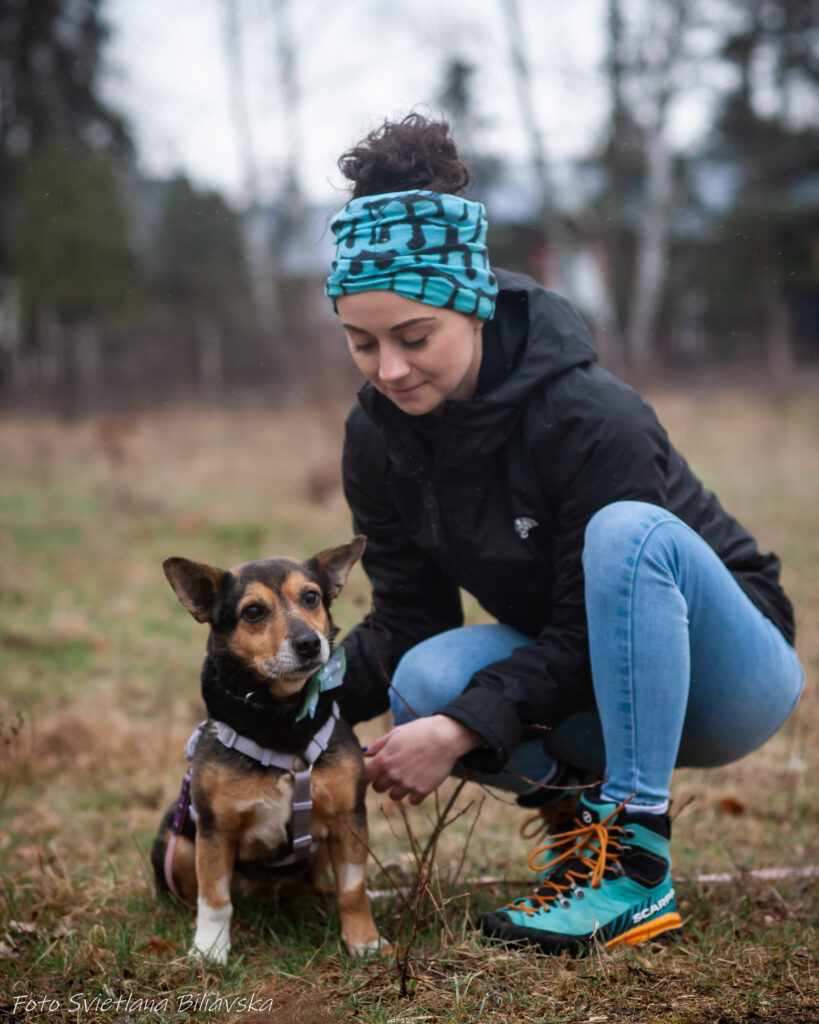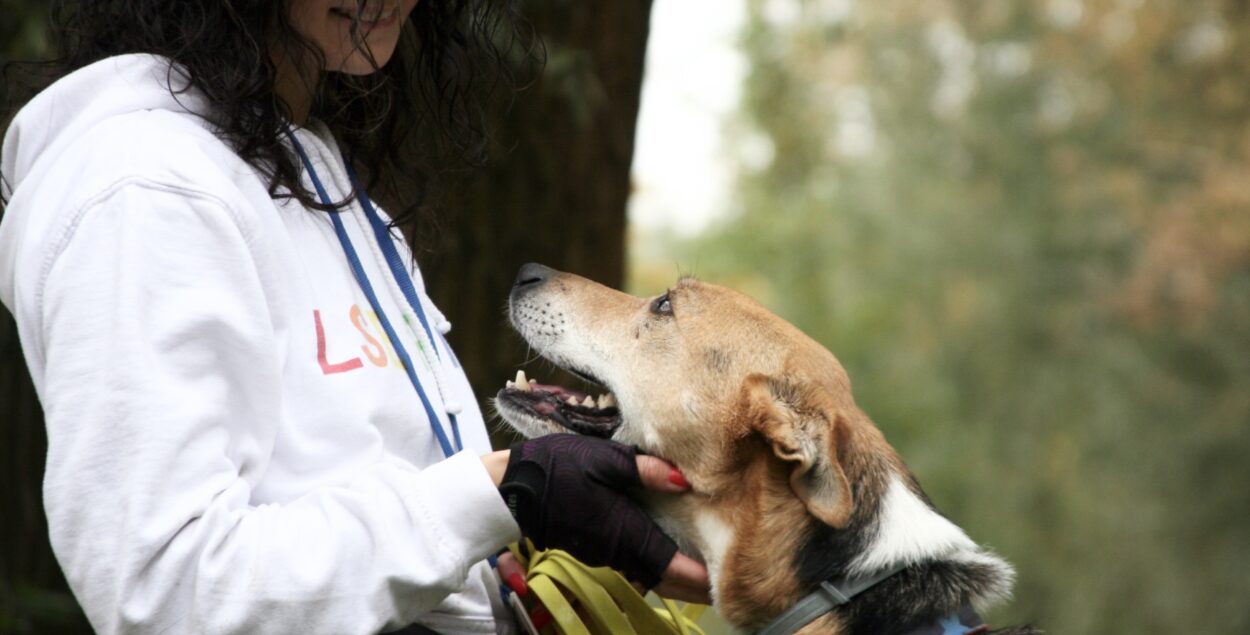Anthropomorphism! Aversion! Alpha, beta, omega… eee macarena! You know those clickbait titles, don’t you? These and many other, more or less comprehensible, slogans circulate around the Internet and social media, causing concern among dog lovers who wish to deepen their understanding of their companions.
Is it possible to understand dogs? Well, no…
On the one hand, we are bombarded with convoluted content full of the jargon of professional behaviourists, for whom every movement of a dog’s ear or eye seems as self-evident as 2 + 2 = 4. On the other – colourful, eye-catching videos criticising that dreadful anthropomorphism (whatever that actually is), yet in those same videos, the dogs are dressed in gear reminiscent of instruments of torture…
Before, utterly disheartened by this chaos, you decide to put down your phone or close your computer and conclude that understanding dogs is black magic requiring some higher level of initiation, I’ll try – in this and every following article – to clear up some of the doubts and help you understand your dog’s world a little better. Contrary to appearances, it won’t be that difficult, because the centre of that world is… you!
As for me – my name is Aga. I work with canine fears, frustrations, and other issues as an animal psychologist, shelter volunteer, pet sitter, and foster carer for dogs in need, and I have the honour and pleasure of sharing a piece of my passion with you. I have completed not only animal psychology at SWPS University, but also human psychology at University College London, so get ready for some tasty morsels (pun absolutely intended) from the fields of biology and neurology as well. Ready?

Let’s begin our DOGventure!
It’s time for a DOGventure! For a moment, I was tempted to start this paragraph with the words ‘The key to understanding dogs is…’. However, that moment was as pleasant as it was fleeting, because the key to understanding dogs… you guessed it, doesn’t exist! Just as we have no universal way of understanding all people due to our diversity, it is equally impossible to sum up such complex, highly developed mammals as dogs in a single sentence. In short: every dog, just like every person, is different!
But… isn’t this comparison of dogs to people exactly that dreadful anthropomorphism we are warned about at every turn?
Let’s start with a definition: according to the PWN Dictionary of the Polish Language1, anthropomorphism is ‘a figure of speech consisting in attributing human traits to animals, plants, objects, phenomena, or abstract concepts’. Phew – so, one does not commit the sin of anthropomorphising their dog unless they attributes to it exclusively human qualities – and those, as it turns out, are surprisingly few.
I much more often observe among carers a tendency to underestimate how complex their dog truly is and how rich an emotional life it has (rich does not mean identical to that of a human), rather than owners anthropomorphising their companions excessively. Personally, I believe that it is precisely the tendency to oversimplify canine reactions and confine them solely within the framework of reinforcement – that is, within the concept of strengthening and extinguishing behaviours derived from Skinner’s theory (Skinner, 1958)2 – while denying them an emotional component, that is far more harmful to dogs than attempts to explore their communication and perception of the world. Why? Because it strips us of empathy towards our four-legged friends, which is… well, perhaps empathy itself is that mythical key to understanding dogs after all.
Before, however, I outline a few practical analogies between the human and canine worlds in the next article, which are important in my daily work – especially during the mentally demanding behavioural work with aggressive, fearful, and generally ‘traumatised’ dogs – let us take a look at the scientific data.
How science sees the dog. Let’s start from the beginning
It is precisely by relying on scientific research that we are able to analyse the complexity of dogs’ emotions, while at the same time respecting their difference from human emotions, so that we can coexist happily – but also safely – with our four-legged companions.
Starting from childhood: it turns out that in dogs, just as in humans, we can distinguish different styles of attachment to their guardian – and these are analogous to the types of relationships between a child and mother identified in other studies. This phenomenon was examined using a modified version of the SST (Strange Situation Test), originally used to study children’s attachment styles according to Bowlby’s Theory.
As we go further, thanks to imaging studies using, among other methods, magnetic resonance neuroimaging, we know that in both dogs and humans, emotions influence memory and its consolidation, as well as cognitive abilities and the capacity to learn new skills.
In a threatening situation, when the brain is flooded with cortisol and adrenaline (and let’s remember, dogs may define ‘threat’ quite differently), the amygdala in our brains ‘takes over’, because survival takes priority over remembering and learning.
I wrote ‘in our brains’ because the structure of the canine and human brain is surprisingly similar! In practice, this means that a dog, just like a human, needs a sense of safety in order to acquire new skills or work on problematic behaviours.
Thanks to such scientific data, it becomes clear that the use of aversive tools, such as prong collars, choke chains, or electric collars, as well as other forms of violence and intimidation, does not support effective work with dogs. ‘Effective’ meaning work that produces long-term results, because it is difficult to achieve a sense of safety – and thus learning – in the face of stress.

Dogs get stressed like humans do
‘Hang on a moment,’ you might say – ‘how do we know that dogs experience stress during aversive training?’ I’ll answer: from research, of course! A Portuguese study tells us that dogs trained with aversive methods (physically punished) and mixed methods (both rewarded and punished) had higher levels of cortisol (commonly known as the stress hormone) in their saliva and displayed more stress signals in their body language than dogs trained without violence.
If we also take into account that the absence of harmful stress is essential for the development of a secure attachment style, it becomes obvious that we should focus on building relationships with our dogs and learning their communication – not only so that they feel safe with us, but also so that we can effectively set boundaries for them! How? I’ll try to tell you about that in the following articles.
Anthropomorphism of dogs is harmful
So, we have established that dogs experience emotions and share many things with us. Why, then, do we still repeat that anthropomorphism is harmful? Why shouldn’t we expect our dog to draw conclusions from a punishment delivered upon our return home for having chewed our slippers a few hours earlier? The answer is simple: the fact that we share much does not exclude the fact that much also divides us! Alexandra Horowitz conducted an experiment in which a guardian, in the presence of a dog, placed a biscuit on a table, forbade the dog to eat it, and then left the room.
Regardless of whether the dog ate the biscuit in the guardian’s absence or not, it received a reprimand upon their return. In both cases, the dogs displayed the so-called ‘guilty look’ – body language often mistakenly interpreted as a dog’s sense of guilt. The conclusion is that the dogs were reacting to the guardian’s behaviour, not because they actually felt guilty. Does that mean that dogs do not experience guilt?
Not necessarily – at present, we do not know. It does, however, mean that they may experience it differently, or in different situations, than humans do – much like disgust. Dogs roll in and eat things that we find revolting, yet they still display signals of disgust – simply in different contexts. One of the dogs who stayed with me in my foster home used to twist his face in distaste and almost gag at… bananas!
Emotions, attachment styles, brains… that’s quite a lot. What can we take away from this flood of information? Well, the summary is actually quite simple: it is worth learning about dogs in order to understand them and to be empathetic towards them, because we share so much. However, we should not approach dogs naively or anthropomorphise them uncritically – scientific research clearly shows that although there are many similarities, there are also plenty of differences dividing us. And it is precisely those differences that make the canine world so fascinating!
- Wielki Słownik Ortograficzny PWN [Great PWN Spelling Dictionary]*. anthropomorphism – definition, synonyms, examples of use. https://sjp.pwn.pl/slowniki/antropomorfizacja.html
- Skinner, B. F. (1958). Reinforcement today. American Psychologist, 13(3), 94– 99.
- Topál, J., Miklósi, Á., Csányi, V., & Dóka, A. (1998). Attachment behavior in dogs (Canis familiaris): A new application of Ainsworth’s (1969) Strange Situation Test. Journal of Comparative Psychology, 112(3), 219–229.
- Ainsworth, M. D. (1985a). Patterns of attachment. PsycEXTRA Dataset.
- McGaugh, J. L. (1998). Role of stress hormones and the amygdala in regulating memory storage. Behavioural Pharmacology, 9(1).
- Vieira de Castro, A. C., Fuchs, D., Pastur, S., de Sousa, L., & Olsson, I. A. (2019). Does Training Method Matter?: Evidence for the Negative Impact of Aversive-Based Methods on Companion Dog Welfare.
- Horowitz, A. (2009). Disambiguating the “guilty look”: Salient prompts to a familiar dog behaviour. Behavioural Processes, 81(3), 447–452.
